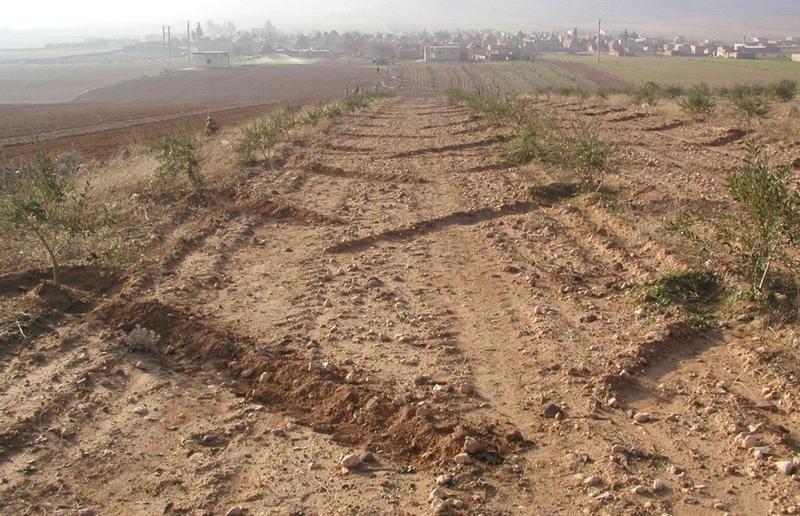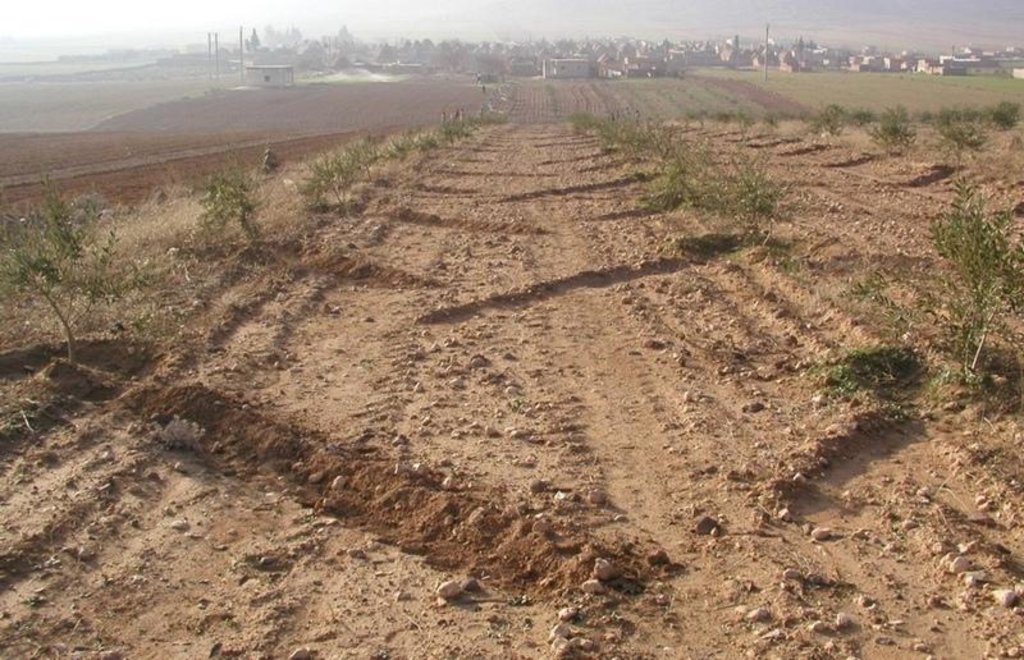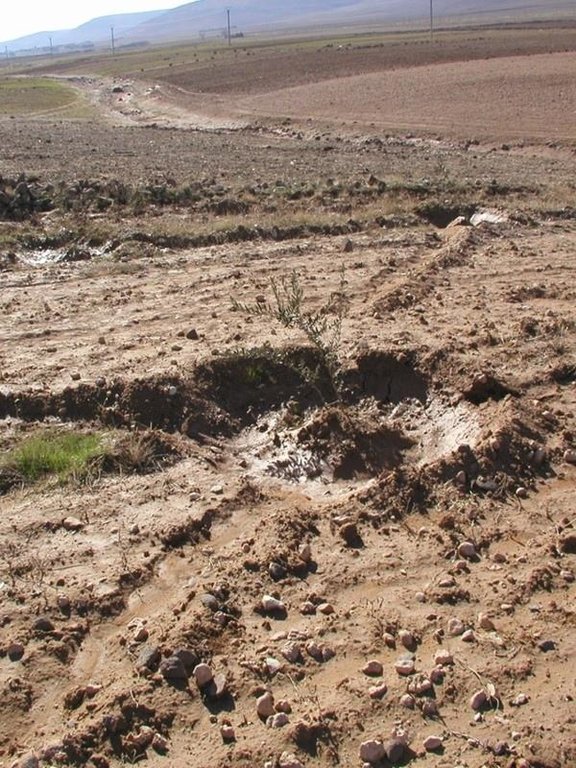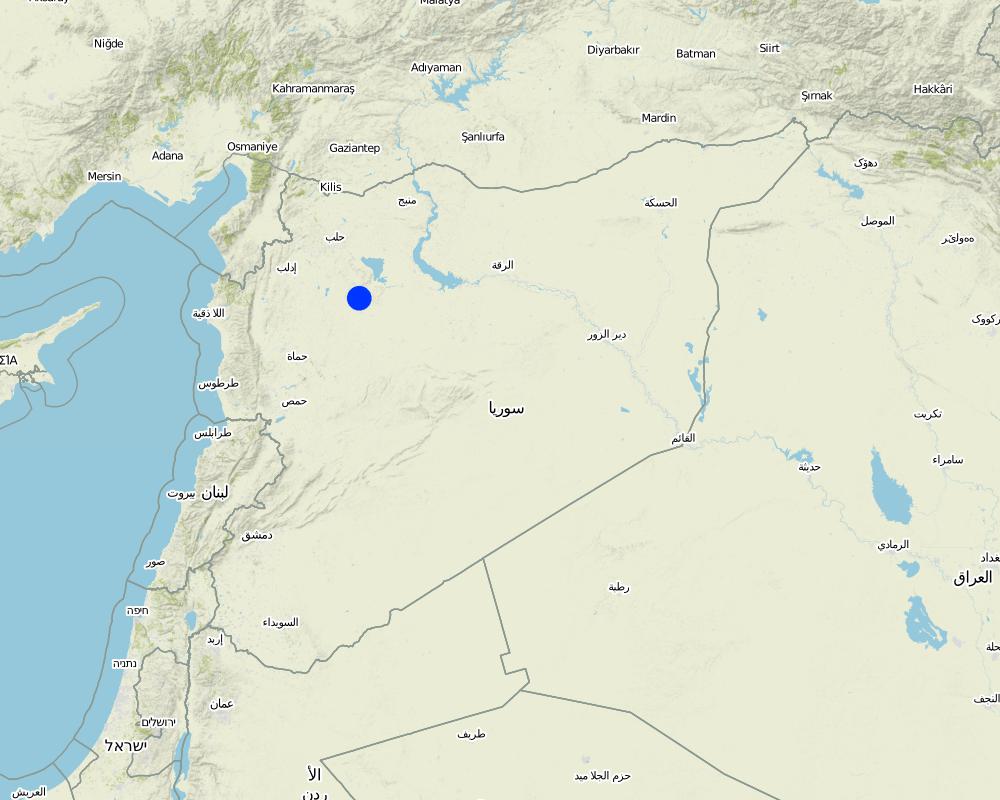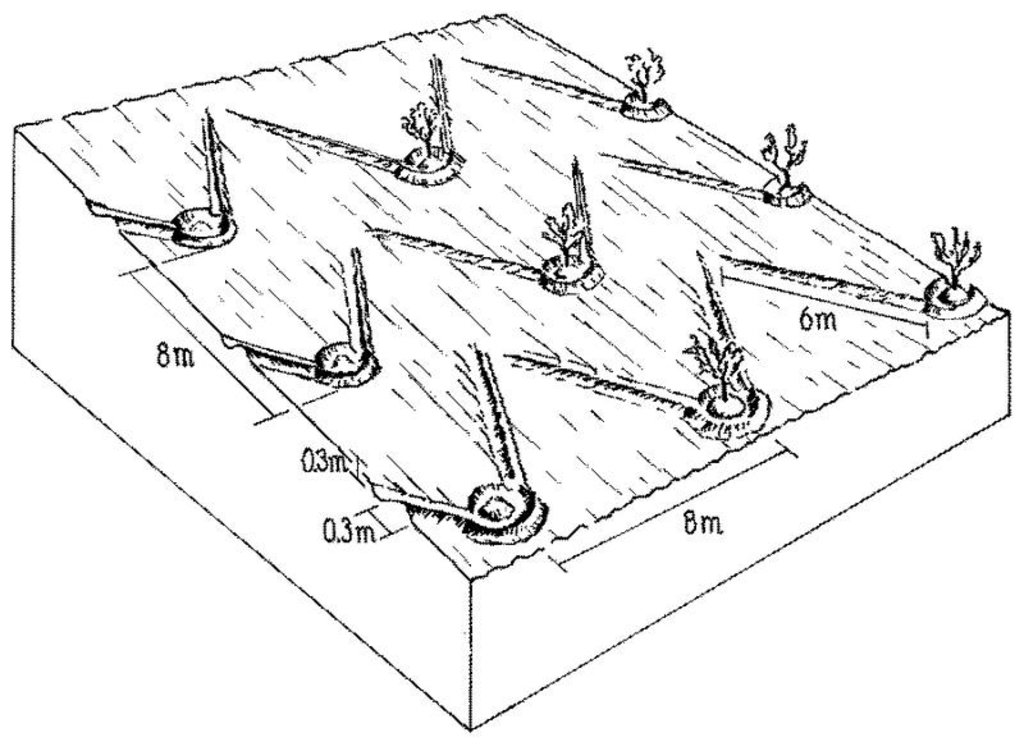Furrow-enhanced runoff harvesting for olives [Syrian Arab Republic]
- Creation:
- Update:
- Compiler: Francis Turkelboom
- Editor: –
- Reviewers: Deborah Niggli, Alexandra Gavilano
technologies_1005 - Syrian Arab Republic
View sections
Expand all Collapse all1. General information
1.2 Contact details of resource persons and institutions involved in the assessment and documentation of the Technology
SLM specialist:
Tubeileh Ashraf
ICARDA
Syrian Arab Republic
SLM specialist:
La Rovere Roberto
Syrian Arab Republic
SLM specialist:
Burggeman Adriana
Syrian Arab Republic
Name of project which facilitated the documentation/ evaluation of the Technology (if relevant)
Book project: where the land is greener - Case Studies and Analysis of Soil and Water Conservation Initiatives Worldwide (where the land is greener)Name of project which facilitated the documentation/ evaluation of the Technology (if relevant)
Book project: Water Harvesting – Guidelines to Good Practice (Water Harvesting)Name of the institution(s) which facilitated the documentation/ evaluation of the Technology (if relevant)
International Center for Agricultural Research in the Dry Areas (ICARDA) - Lebanon1.3 Conditions regarding the use of data documented through WOCAT
The compiler and key resource person(s) accept the conditions regarding the use of data documented through WOCAT:
Yes
1.4 Declaration on sustainability of the described Technology
Is the Technology described here problematic with regard to land degradation, so that it cannot be declared a sustainable land management technology?
No
1.5 Reference to Questionnaire(s) on SLM Approaches (documented using WOCAT)
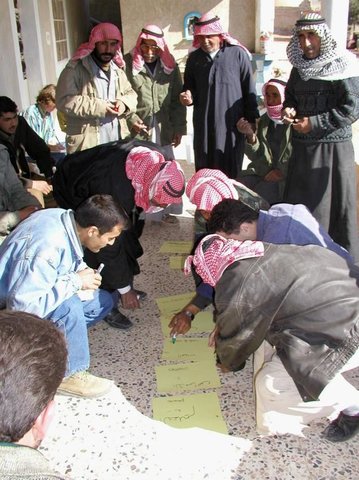
Participatory technology development [Syrian Arab Republic]
Participatory technology development, through close researcher-farmer interaction, for sustainable land management of olive orchards in dry marginal areas.
- Compiler: Francis Turkelboom
2. Description of the SLM Technology
2.1 Short description of the Technology
Definition of the Technology:
Runoff harvesting through annually constructed V-shaped microcatchments, enhanced by downslope ploughing.
2.2 Detailed description of the Technology
Description:
The Khanasser Valley in north-west Syria is a marginal agricultural area, with annual rainfall of about 220 mm/year. Soils are shallow and poor in productivity. The footslopes of degraded hills are traditionally used for extensive grazing or barley cultivation. However to achieve self-sufficiency in olive oil production, several farmers have developed orchards in this area - which is generally considered too dry for olives.
Trees are spaced at 8 m apart, within and between rows. Traditionally, farmers prefer to till their orchards by tractor in order to keep them weed-free (weeds may attract sheep, lead to fires and compete for water with the olive trees). As this tillage operation is usually practised up and down the slope, the resulting furrows stimulate runoff and erosion. However, when this is combined with Vshaped and/or fish-bone shaped microcatchments around individual trees, the furrows created can be used to harvest runoff water for improved production.
The V-shape earthen bunds (reinforced with some stones) are constructed manually, by hoe, around each tree. The furrows then divert runoff systematically to the microcatchments where it concentrates in basins around the trees. Each tree is effectively served by a catchment area of 60 m2. The catchment: cultivated area ratio is thus approximately 60:1 (assuming the area exploited by the tree.
This technology saves irrigation water during the dry season, enhances soil moisture storage, and stimulates olive tree growth. Furthermore, fine particles of eroded soil are captured in the microcatchments. While these may be nutrientrich, they also tend to seal the surface. The bunds need to be rebuilt every year. If the structures are damaged after a heavy storm, they need to be repaired. Labour input for establishment and maintenance is low, the technology is easy and cheap to maintain, and there is enough local skill to sustain and expand the system. A supporting technology is to mulch the area around each tree with locally available stones (limestone and/or basalt) to reduce soil temperature during the summer, decrease surface evaporation and improve infiltration. The catchment areas between the trees are sometimes planted with low water-demanding winter annuals (lentils, vetch, barley, etc) especially when the trees are young. This helps to reduce surface erosion. Implementation of furrow-enhanced runoff water harvesting in olive orchards started in 2002, and adoption by farmers is growing gradually.
2.3 Photos of the Technology
2.5 Country/ region/ locations where the Technology has been applied and which are covered by this assessment
Country:
Syrian Arab Republic
Region/ State/ Province:
Aleppo, NW Syria
Further specification of location:
Khanasser Valley
Comments:
Total area covered by the SLM Technology is 0.05 km2.
Map
×2.7 Introduction of the Technology
Specify how the Technology was introduced:
- through projects/ external interventions
3. Classification of the SLM Technology
3.1 Main purpose(s) of the Technology
- improve production
- reduce, prevent, restore land degradation
- create beneficial economic impact
3.2 Current land use type(s) where the Technology is applied
Land use mixed within the same land unit:
Yes
Specify mixed land use (crops/ grazing/ trees):
- Silvo-pastoralism

Cropland
- Annual cropping
- Tree and shrub cropping
Annual cropping - Specify crops:
- cereals - barley
- lentils, vetch
Tree and shrub cropping - Specify crops:
- olive
Number of growing seasons per year:
- 1
Specify:
Longest growing period in days: 150, Longest growing period from month to month: Dec - Apr

Grazing land

Forest/ woodlands
Comments:
Major land use problems (compiler’s opinion): There are a series of problems in this area, including: low and erratic rainfall, drought, low land productivity, poor water use efficiency, land degradation, limited ground water for irrigation, few agricultural options, and low income from agriculture.
Semi-nomadism / pastoralism: before SWC
3.3 Has land use changed due to the implementation of the Technology?
Has land use changed due to the implementation of the Technology?
- No (Continue with question 3.4)
Land use mixed within the same land unit:
Yes
Comments:
Semi-nomadism / pastoralism: before SWC
3.4 Water supply
Water supply for the land on which the Technology is applied:
- rainfed
3.5 SLM group to which the Technology belongs
- water harvesting
- irrigation management (incl. water supply, drainage)
- water diversion and drainage
3.6 SLM measures comprising the Technology

agronomic measures

structural measures
3.7 Main types of land degradation addressed by the Technology

soil erosion by water
- Wt: loss of topsoil/ surface erosion

soil erosion by wind
- Et: loss of topsoil

chemical soil deterioration
- Cn: fertility decline and reduced organic matter content (not caused by erosion)

water degradation
- Ha: aridification
3.8 Prevention, reduction, or restoration of land degradation
Specify the goal of the Technology with regard to land degradation:
- restore/ rehabilitate severely degraded land
4. Technical specifications, implementation activities, inputs, and costs
4.1 Technical drawing of the Technology
Technical specifications (related to technical drawing):
V-shaped micro-catchments which harvest water for the olive trees: the furrows up-and-down slope help channel the runoff to the olives.
Technical knowledge required for field staff / advisors: low
Technical knowledge required for land users: low
Main technical functions: control of dispersed runoff: retain / trap, increase / maintain water stored in soil, water harvesting / increase water supply
Secondary technical functions: reduction of slope length, sediment retention / trapping, sediment harvesting, reduction in wind speed
Agronomic measure: up and down tillage
Remarks: (for runoff collection)
Structural measure: V-shaped bunds
Structural measure: mulching with stones (supportive, see also 2.8)
Construction material (stone): limestone, basalt (locally available)
Author:
Mats Gurtner
4.3 Establishment activities
| Activity | Timing (season) | |
|---|---|---|
| 1. | Up-and-down tillage by tractor driven plough | in winter |
| 2. | Construction of runoff harvesting bunds and micro-basins, manually by hoe | November/December; beginning of rainy season |
| 3. | V-shaped bunds are seasonal structures and thus established every year. Construction of runoff harvesting bunds and micro-basins |
4.4 Costs and inputs needed for establishment
| Specify input | Unit | Quantity | Costs per Unit | Total costs per input | % of costs borne by land users | |
|---|---|---|---|---|---|---|
| Labour | Construction (10 person days) | ha | 1.0 | 50.0 | 50.0 | 100.0 |
| Equipment | Machine use | ha | 1.0 | 10.0 | 10.0 | 100.0 |
| Equipment | Tools | ha | 1.0 | 3.0 | 3.0 | 100.0 |
| Total costs for establishment of the Technology | 63.0 | |||||
| Total costs for establishment of the Technology in USD | 63.0 | |||||
4.5 Maintenance/ recurrent activities
| Activity | Timing/ frequency | |
|---|---|---|
| 1. | Maintenance of bunds in winter/rainy season | after heavy rainfall 1-3 times a year |
4.6 Costs and inputs needed for maintenance/ recurrent activities (per year)
| Specify input | Unit | Quantity | Costs per Unit | Total costs per input | % of costs borne by land users | |
|---|---|---|---|---|---|---|
| Labour | Repair (5 person days) | ha | 1.0 | 25.0 | 25.0 | 100.0 |
| Total costs for maintenance of the Technology | 25.0 | |||||
| Total costs for maintenance of the Technology in USD | 25.0 | |||||
Comments:
Machinery/ tools: tractor, hoe, tractor-driven plough
The calculation covers the runoff harvesting technology alone - annual activities of ploughing and water harvesting structure establishment and maintenance. Planting of olive trees and their maintenance are not included here.
5. Natural and human environment
5.1 Climate
Annual rainfall
- < 250 mm
- 251-500 mm
- 501-750 mm
- 751-1,000 mm
- 1,001-1,500 mm
- 1,501-2,000 mm
- 2,001-3,000 mm
- 3,001-4,000 mm
- > 4,000 mm
Agro-climatic zone
- semi-arid
5.2 Topography
Slopes on average:
- flat (0-2%)
- gentle (3-5%)
- moderate (6-10%)
- rolling (11-15%)
- hilly (16-30%)
- steep (31-60%)
- very steep (>60%)
Landforms:
- plateau/plains
- ridges
- mountain slopes
- hill slopes
- footslopes
- valley floors
Altitudinal zone:
- 0-100 m a.s.l.
- 101-500 m a.s.l.
- 501-1,000 m a.s.l.
- 1,001-1,500 m a.s.l.
- 1,501-2,000 m a.s.l.
- 2,001-2,500 m a.s.l.
- 2,501-3,000 m a.s.l.
- 3,001-4,000 m a.s.l.
- > 4,000 m a.s.l.
Comments and further specifications on topography:
Slopes on average: Also rolling (ranked 2) and gentle (ranked 3)
5.3 Soils
Soil depth on average:
- very shallow (0-20 cm)
- shallow (21-50 cm)
- moderately deep (51-80 cm)
- deep (81-120 cm)
- very deep (> 120 cm)
Soil texture (topsoil):
- medium (loamy, silty)
Topsoil organic matter:
- low (<1%)
If available, attach full soil description or specify the available information, e.g. soil type, soil PH/ acidity, Cation Exchange Capacity, nitrogen, salinity etc.
Soil depth on average: Also shallow (ranked 2) and deep (ranked 3)
Soil fertility: Low (ranked 1) and very low (ranked 2)
Soil drainage/infiltration: Good (ranked 1) and medium (ranked 2)
5.6 Characteristics of land users applying the Technology
Market orientation of production system:
- mixed (subsistence/ commercial)
Off-farm income:
- 10-50% of all income
Indicate other relevant characteristics of the land users:
Off-farm income specification: from farm labour and non-agricultural activities in nearby cities
5.7 Average area of land used by land users applying the Technology
- < 0.5 ha
- 0.5-1 ha
- 1-2 ha
- 2-5 ha
- 5-15 ha
- 15-50 ha
- 50-100 ha
- 100-500 ha
- 500-1,000 ha
- 1,000-10,000 ha
- > 10,000 ha
Comments:
Average area of land owned or leased by land users applying the Technology: Also 5-15 ha (ranked 3)
5.8 Land ownership, land use rights, and water use rights
- individual
Land use rights:
- individual
6. Impacts and concluding statements
6.1 On-site impacts the Technology has shown
Socio-economic impacts
Production
crop production
land management
Water availability and quality
irrigation water availability
Comments/ specify:
Through water saving
Income and costs
workload
Other socio-economic impacts
Tree growth
Dependency on tractor
Socio-cultural impacts
SLM/ land degradation knowledge
Landscape and environmental quality
Ecological impacts
Water cycle/ runoff
surface runoff
Soil
soil moisture
soil loss
nutrient cycling/ recharge
Comments/ specify:
Increase in soil fertility
Biodiversity: vegetation, animals
plant diversity
animal diversity
habitat diversity
pest/ disease control
Comments/ specify:
Increased weed growth around trees
Climate and disaster risk reduction
wind velocity
6.2 Off-site impacts the Technology has shown
downstream flooding
downstream siltation
6.4 Cost-benefit analysis
How do the benefits compare with the maintenance/ recurrent costs (from land users' perspective)?
Short-term returns:
positive
6.5 Adoption of the Technology
Of all those who have adopted the Technology, how many did so spontaneously, i.e. without receiving any material incentives/ payments?
- 91-100%
Comments:
100% of land user families have adopted the Technology without any external material support. There is a little trend towards spontaneous adoption of the Technology. Generally moderate adoption: Mainly applied by ‘agriculturalists’, that is households whose livelihoods mainly depend on agriculture. Farmers with more interest in off-farm labour or sheep rearing - less interested. Is expanding slowly but gradually.
6.7 Strengths/ advantages/ opportunities of the Technology
| Strengths/ advantages/ opportunities in the compiler’s or other key resource person’s view |
|---|
| Increases soil moisture storage in low rainfall areas and allows expansion of olive plantation into drier areas |
| Easy, low-cost and requires no extra external inputs. |
| Reduces soil erosion. |
| Reduces summer irrigation needs |
| Improves olive productivity |
6.8 Weaknesses/ disadvantages/ risks of the Technology and ways of overcoming them
| Weaknesses/ disadvantages/ risks in the compiler’s or other key resource person’s view | How can they be overcome? |
|---|---|
| Extra labour needed | Construct during off-season. |
| Increases weed growth in the tree basin | More stone mulching. |
| Trees will still need some irrigation in summer | Make irrigation practices more efficient. |
7. References and links
7.1 Methods/ sources of information
- field visits, field surveys
- interviews with land users
When were the data compiled (in the field)?
01/11/2004
7.2 References to available publications
Title, author, year, ISBN:
Tubeileh A and Turkelboom F, Participatory research on water and soil management with olive growers in the KhanasserValley. KVIRS project, ICARDA, Aleppo, Syria. 2004.
Title, author, year, ISBN:
Tubeileh A, Bruggeman A and Turkelboom F, Growing olive and other tree species in marginaldry environments. ICARDA, Aleppo, Syria. 2004.
Links and modules
Expand all Collapse allLinks

Participatory technology development [Syrian Arab Republic]
Participatory technology development, through close researcher-farmer interaction, for sustainable land management of olive orchards in dry marginal areas.
- Compiler: Francis Turkelboom
Modules
No modules


